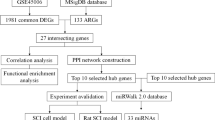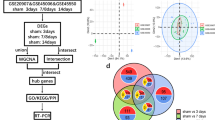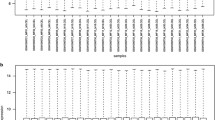Abstract
Programmed cell death (PCD) is an important pathologic process after spinal cord injury (SCI). As a new type of PCD, ferroptosis is involved in the secondary SCI. However, the underlying molecular mechanism remains unclear. In this study, we validated ferroptotic phenotype in an animal model of SCI. Then, the bioinformatic analyses performed on a microarray data of SCI (GSE45006). KEGG analysis suggested that the pathways of mTOR, HIF-1, VEGF, and protein process in endoplasmic reticulum were involved in SCI-induced ferroptosis. GO analysis revealed that oxidative stress, amide metabolic process, cation transport, and cytokine production were essential biological processes in ferroptosis after SCI. We highlighted five genes including ATF-3, XBP-1, HMOX-1, DDIT-3, and CHAC-1 as ferroptotic key gene in SCI. These results contribute to exploring the ferroptotic mechanism underlying the secondary SCI and providing potential targets for clinical treatment.











Similar content being viewed by others
Data Availability
The original contributions presented in the study are included in the article/supplementary material. Further inquiries can be directed to the corresponding authors.
References
Adams MM, Hicks AL (2005) Spasticity after spinal cord injury. Spinal Cord 43:577–586. https://doi.org/10.1038/sj.sc.3101757
Vacca V, Madaro L, De Angelis F, Proietti D, Cobianchi S, Orsini T, Puri PL, Luvisetto S, et al. (2020) Revealing the Therapeutic potential of botulinum neurotoxin type A in counteracting paralysis and neuropathic pain in spinally injured mice. Toxins (Basel) 12(8):491. https://doi.org/10.3390/toxins12080491
Chen Y, Liu S, Li J, Li Z, Quan J, Liu X, Tang Y, Liu B (2020) The latest view on the mechanism of ferroptosis and its research progress in spinal cord injury. Oxid Med Cell Longev. 6375938. https://doi.org/10.1155/2020/6375938.
Wu C, Xu H, Li J, Hu X, Wang X, Huang Y, Li Y, Sheng S, et al. (2020) Baicalein attenuates pyroptosis and endoplasmic reticulum stress following spinal cord ischemia-reperfusion injury via autophagy enhancement. Front Pharmacol 11:1076. https://doi.org/10.3389/fphar.2020.01076
Fan H, Tang HB, Shan LQ, Liu SC, Huang DG, Chen X, Chen Z, Yang M, et al. (2019) Quercetin prevents necroptosis of oligodendrocytes by inhibiting macrophages/microglia polarization to M1 phenotype after spinal cord injury in rats. J Neuroinflammation 16(1):206. https://doi.org/10.1186/s12974-019-1613-2
Wang W, Huang X, Li J, Sun A, Yu J, Xie N, Xi Y, Ye X (2017) Methane suppresses microglial activation related to oxidative, inflammatory, and apoptotic injury during spinal cord injury in rats. Oxid Med Cell Longev. 2190897. https://doi.org/10.1155/2017/2190897.
Dixon SJ, Lemberg KM, Lamprecht MR, Skouta R, Zaitsev EM, Gleason CE, Patel DN, Bauer AJ, et al. (2012) Ferroptosis: an iron-dependent form of nonapoptotic cell death. Cell 149(5):1060–1072. https://doi.org/10.1016/j.cell.2012.03.042
Shen L, Lin D, Li X, Wu H, Lenahan C, Pan Y, Xu W, Chen Y, et al. (2020) Ferroptosis in acute central nervous system injuries: the future direction? Front Cell Dev Biol 8:594. https://doi.org/10.3389/fcell.2020.00594
Zhang Y, Fan BY, Pang YL, Shen WY, Wang X, Zhao CX, Li WX, Liu C, et al. (2020) Neuroprotective effect of deferoxamine on erastin-induced ferroptosis in primary cortical neurons. Neural Regen Res 15(8):1539–1545. https://doi.org/10.4103/1673-5374.274344
Zhang Y, Sun C, Zhao C, Hao J, Zhang Y, Fan B, Li B, Duan H, et al. (2019) Ferroptosis inhibitor SRS 16–86 attenuates ferroptosis and promotes functional recovery in contusion spinal cord injury. Brain Res 1706:48–57. https://doi.org/10.1016/j.brainres.2018.10.023
Yao X, Zhang Y, Hao J, Duan HQ, Zhao CX, Sun C, Li B, Fan BY, et al. (2019) Deferoxamine promotes recovery of traumatic spinal cord injury by inhibiting ferroptosis. Neural Regen Res 14(3):532–541. https://doi.org/10.4103/1673-5374.245480
Barrett T, Wilhite SE, Ledoux P, Evangelista C, Kim IF, Tomashevsky M, Marshall KA, Phillippy KH, et al. (2013) NCBI GEO: archive for functional genomics data sets--update. Nucleic Acids Res. 41(Database issue): D991–5. https://doi.org/10.1093/nar/gks1193.
Zhou N, Bao J (2020) FerrDb: a manually curated resource for regulators and markers of ferroptosis and ferroptosis-disease associations. Database (Oxford). https://doi.org/10.1093/database/baaa021
Zhong L, Zhang H, Ding ZF, Li J, Lv JW, Pan ZJ, Xu DX, Yin ZS (2020) Erythropoietin-induced autophagy protects against spinal cord injury and improves neurological function via the extracellular-regulated protein kinase signaling pathway. Mol Neurobiol 57(10):3993–4006. https://doi.org/10.1007/s12035-020-01997-0
Xin W, Qiang S, Jianing D, Jiaming L, Fangqi L, Bin C, Yuanyuan C, Guowang Z, et al. (2021) Human bone marrow mesenchymal stem cell-derived exosomes attenuate blood-spinal cord barrier disruption via the TIMP2/MMP pathway after acute spinal cord injury. Mol Neurobiol 58(12):6490–6504. https://doi.org/10.1007/s12035-021-02565-w
Gao C, Chen X, Xu H, Guo H, Zheng L, Yan Y, Ren Z, Luo C, et al. (2022) Restraint stress delays the recovery of neurological impairments and exacerbates brain damages through activating endoplasmic reticulum stress-mediated neurodegeneration/autophagy/apopotosis post moderate traumatic brain injury. Mol Neurobiol 59(3):1560–1576. https://doi.org/10.1007/s12035-022-02735-4
Basso DM, Beattie MS, Bresnahan JC (1995) A sensitive and reliable locomotor rating scale for open field testing in rats. J Neurotrauma 12(1):1–21. https://doi.org/10.1089/neu.1995.12.1
da Huang W, Sherman BT, Lempicki RA (2009) Bioinformatics enrichment tools: paths toward the comprehensive functional analysis of large gene lists. Nucleic Acids Res 37(1):1–13. https://doi.org/10.1093/nar/gkn923
Fang S, Zhong L, Wang AQ, Zhang H, Yin ZS (2021) Identification of regeneration and hub genes and pathways at different time points after spinal cord injury. Mol Neurobiol 58(6):2643–2662. https://doi.org/10.1007/s12035-021-02289-x
Bu D, Luo H, Huo P, Wang Z, Zhang S, He Z, Wu Y, Zhao L, et al. (2021) KOBAS-i: intelligent prioritization and exploratory visualization of biological functions for gene enrichment analysis. Nucleic Acids Res 49(W1):W317–W325. https://doi.org/10.1093/nar/gkab447
Xu N, Cui Y, Dong J, Huang L (2020) Exploring the molecular mechanisms of pterygium by constructing lncRNA-miRNA-mRNA regulatory network. Invest Ophthalmol Vis Sci 61(8):12. https://doi.org/10.1167/iovs.61.8.12
Subramanian A, Tamayo P, Mootha VK, Mukherjee S, Ebert BL, Gillette MA, Paulovich A, Pomeroy SL, et al. (2005) Gene set enrichment analysis: a knowledge-based approach for interpreting genome-wide expression profiles. Proc Natl Acad Sci U S A 102(43):15545–15550. https://doi.org/10.1073/pnas.0506580102
Peng S, Yang S, Bo X, Li F (2017) paraGSEA: a scalable approach for large-scale gene expression profiling. Nucleic Acids Res 45(17):e155. https://doi.org/10.1093/nar/gkx679
Szklarczyk D, Gable AL, Nastou KC, Lyon D, Kirsch R, Pyysalo S, Doncheva NT, Legeay M, et al. (2021) The STRING database in 2021: customizable protein-protein networks, and functional characterization of user-uploaded gene/measurement sets. Nucleic Acids Res 49(D1):D605–D612. https://doi.org/10.1093/nar/gkaa1074
Shannon P, Markiel A, Ozier O, Baliga NS, Wang JT, Ramage D, Amin N, Schwikowski B, Ideker T (2003) Cytoscape: a software environment for integrated models of biomolecular interaction networks. Genome Res 13(11):2498–2504. https://doi.org/10.1101/gr.1239303
Chamankhah M, Eftekharpour E, Karimi-Abdolrezaee S, Boutros PC, San-Marina S, Fehlings MG (2013 Aug) Genome-wide gene expression profiling of stress response in a spinal cord clip compression injury model. BMC Genomics 28(14):583. https://doi.org/10.1186/1471-2164-14-583
Wang W, Su Y, Tang S, Li H, Xie W, Chen J, Shen L, Pan X, et al. (2019) Identification of noncoding RNA expression profiles and regulatory interaction networks following traumatic spinal cord injury by sequence analysis. Aging (Albany NY) 11(8):2352–2368. https://doi.org/10.18632/aging.101919
Yao XQ, Liu ZY, Chen JY, Huang ZC, Liu JH, Sun BH, Zhu QA, Ding RT, et al. (2021) Proteomics and bioinformatics reveal insights into neuroinflammation in the acute to subacute phases in rat models of spinal cord contusion injury. FASEB J 35(7):e21735. https://doi.org/10.1096/fj.202100081RR
Zhou H, Yin C, Zhang Z, Tang H, Shen W, Zha X, Gao M, Sun J, et al. (2020) Proanthocyanidin promotes functional recovery of spinal cord injury via inhibiting ferroptosis. J Chem Neuroanat 107:101807. https://doi.org/10.1016/j.jchemneu.2020.101807
Ge MH, Tian H, Mao L, Li DY, Lin JQ, Hu HS, Huang SC, Zhang CJ, et al. (2021) Zinc attenuates ferroptosis and promotes functional recovery in contusion spinal cord injury by activating Nrf2/GPX4 defense pathway. CNS Neurosci Ther 27(9):1023–1040. https://doi.org/10.1111/cns.13657
Kanno H, Ozawa H, Sekiguchi A, Yamaya S, Tateda S, Yahata K, Itoi E (2012) The role of mTOR signaling pathway in spinal cord injury. Cell Cycle 11(17):3175–3179. https://doi.org/10.4161/cc.21262
Chen H, Xu G, Wu Y, Wang X, Wang F, Zhang Y (2021) HBO-PC promotes locomotor recovery by reducing apoptosis and inflammation in SCI rats: the role of the mTOR signaling pathway. Cell Mol Neurobiol 41(7):1537–1547. https://doi.org/10.1007/s10571-020-00921-3
Liu Y, Wang Y, Liu J, Kang R, Tang D (2021) Interplay between MTOR and GPX4 signaling modulates autophagy-dependent ferroptotic cancer cell death. Cancer Gene Ther 28(1–2):55–63. https://doi.org/10.1038/s41417-020-0182-y
Han X, Chen Y, Liu Y, Wang Z, Tang G, Tian W (2018) HIF-1α promotes bone marrow stromal cell migration to the injury site and enhances functional recovery after spinal cord injury in rats. J Gene Med 20(12):e3062. https://doi.org/10.1002/jgm.3062
Luo Z, Wu F, Xue E, Huang L, Yan P, Pan X, Zhou Y (2019) Hypoxia preconditioning promotes bone marrow mesenchymal stem cells survival by inducing HIF-1α in injured neuronal cells derived exosomes culture system. Cell Death Dis 10(2):134. https://doi.org/10.1038/s41419-019-1410-y
Yang M, Chen P, Liu J, Zhu S, Kroemer G, Klionsky DJ, Lotze MT, Zeh HJ, et al. (2019) Clockophagy is a novel selective autophagy process favoring ferroptosis. Sci Adv 5(7): eaaw2238. https://doi.org/10.1126/sciadv.aaw2238.
Chen H, Li J, Liang S, Lin B, Peng Q, Zhao P, Cui J, Rao Y (2017) Effect of hypoxia-inducible factor-1/vascular endothelial growth factor signaling pathway on spinal cord injury in rats. Exp Ther Med 13(3):861–866. https://doi.org/10.3892/etm.2017.4049
Zhao X, Gao M, Liang J, Chen Y, Wang Y, Wang Y, Xiao Y, Zhao Z, et al. (2021) SLC7A11 Reduces laser-induced choroidal neovascularization by inhibiting RPE ferroptosis and VEGF production. Front Cell Dev Biol 9:639851. https://doi.org/10.3389/fcell.2021.639851
Oakes SA, Papa FR (2015) The role of endoplasmic reticulum stress in human pathology. Annu Rev Pathol 10:173–194. https://doi.org/10.1146/annurev-pathol-012513-104649
Huang C, Zhang W, Chu F, Qian H, Wang Y, Qi F, Ye M, Zhou J, et al. (2021) Patchouli alcohol improves the integrity of the blood-spinal cord barrier by inhibiting endoplasmic reticulum stress through the Akt/CHOP/caspase-3 pathway following spinal cord injury. Front Cell Dev Biol 9:693533. https://doi.org/10.3389/fcell.2021.693533
McGrath EP, Centonze FG, Chevet E, Avril T, Lafont E (2021) Death sentence: the tale of a fallen endoplasmic reticulum. Biochim Biophys Acta Mol Cell Res 1868(6):119001. https://doi.org/10.1016/j.bbamcr.2021.119001
Dixon SJ, Patel DN, Welsch M, Skouta R, Lee ED, Hayano M, Thomas AG, Gleason CE, et al. (2014) Pharmacological inhibition of cystine-glutamate exchange induces endoplasmic reticulum stress and ferroptosis. Elife 3:e02523. https://doi.org/10.7554/eLife.02523
Rahmani M, Davis EM, Crabtree TR, Habibi JR, Nguyen TK, Dent P, Grant S (2007) The kinase inhibitor sorafenib induces cell death through a process involving induction of endoplasmic reticulum stress. Mol Cell Biol 27(15):5499–5513. https://doi.org/10.1128/MCB.01080-06
Chen D, Fan Z, Rauh M, Buchfelder M, Eyupoglu IY, Savaskan N (2017) ATF4 promotes angiogenesis and neuronal cell death and confers ferroptosis in a xCT-dependent manner. Oncogene 36(40):5593–5608. https://doi.org/10.1038/onc.2017.146
Sarcinelli C, Dragic H, Piecyk M, Barbet V, Duret C, Barthelaix A, Ferraro-Peyret C, Fauvre J, et al. (2020) ATF4-dependent NRF2 transcriptional regulation promotes antioxidant protection during endoplasmic reticulum stress. Cancers (Basel) 12(3):569. https://doi.org/10.3390/cancers12030569
Hai T, Wolfgang CD, Marsee DK, Allen AE, Sivaprasad U (1999) ATF3 and stress responses. Gene Expr 7(4–6):321–335
Huang WL, George KJ, Ibba V, Liu MC, Averill S, Quartu M, Hamlyn PJ, Priestley JV (2007) The characteristics of neuronal injury in a static compression model of spinal cord injury in adult rats. Eur J Neurosci 25(2):362–372. https://doi.org/10.1111/j.1460-9568.2006.05284.x
Wang L, Liu Y, Du T, Yang H, Lei L, Guo M, Ding HF, Zhang J, et al. (2020) ATF3 promotes erastin-induced ferroptosis by suppressing system Xc. Cell Death Differ 27(2):662–675. https://doi.org/10.1038/s41418-019-0380-z
Liou HC, Boothby MR, Finn PW, Davidon R, Nabavi N, Zeleznik-Le NJ, Ting JP, Glimcher LH (1990) A new member of the leucine zipper class of proteins that binds to the HLA DR alpha promoter. Science 247(4950):1581–1584. https://doi.org/10.1126/science.2321018
Chen S, Chen J, Hua X, Sun Y, Cui R, Sha J, Zhu X (2020) The emerging role of XBP1 in cancer. Biomed Pharmacother 127:110069. https://doi.org/10.1016/j.biopha.2020.110069
Saraswat Ohri S, Howard RM, Liu Y, Andres KR, Shepard CT, Hetman M, Whittemore SR (2021) Oligodendrocyte-specific deletion of Xbp1 exacerbates the endoplasmic reticulum stress response and restricts locomotor recovery after thoracic spinal cord injury. Glia 69(2):424–435. https://doi.org/10.1002/glia.23907
Chiang SK, Chen SE, Chang LC (2018) A dual role of heme oxygenase-1 in cancer cells. Int J Mol Sci 20(1):39. https://doi.org/10.3390/ijms20010039
Lettieri-Barbato D, Minopoli G, Caggiano R, Izzo R, Santillo M, Aquilano K, Faraonio R (2020) Fasting drives Nrf2-related antioxidant response in skeletal muscle. Int J Mol Sci 21(20):7780. https://doi.org/10.3390/ijms21207780
Alam MB, Chowdhury NS, Sohrab MH, Rana MS, Hasan CM, Lee SH (2020) Cerevisterol alleviates inflammation via suppression of MAPK/NF-κB/AP-1 and activation of the Nrf2/HO-1 signaling cascade. Biomolecules 10(2):199. https://doi.org/10.3390/biom10020199
Hu H, Tian M, Ding C, Yu S (2019) The C/EBP homologous protein (CHOP) transcription factor functions in endoplasmic reticulum stress-induced apoptosis and microbial infection. Front Immunol 9:3083. https://doi.org/10.3389/fimmu.2018.03083
Gu C, Li H, Wang C, Song X, Ding Y, Zheng M, Liu W, Chen Y, et al. (2017) Bone marrow mesenchymal stem cells decrease CHOP expression and neuronal apoptosis after spinal cord injury. Neurosci Lett 636:282–289. https://doi.org/10.1016/j.neulet.2016.11.032
Penas C, Verdú E, Asensio-Pinilla E, Guzmán-Lenis MS, Herrando-Grabulosa M, Navarro X, Casas C (2011) Valproate reduces CHOP levels and preserves oligodendrocytes and axons after spinal cord injury. Neuroscience 178:33–44. https://doi.org/10.1016/j.neuroscience.2011.01.012
Wang N, Zeng GZ, Yin JL, Bian ZX (2019) Artesunate activates the ATF4-CHOP-CHAC1 pathway and affects ferroptosis in Burkitt’s Lymphoma. Biochem Biophys Res Commun 519(3):533–539. https://doi.org/10.1016/j.bbrc.2019.09.023
Li D, Liu S, Xu J, Chen L, Xu C, Chen F, Xu Z, Zhang Y, et al. (2021) Ferroptosis-related gene CHAC1 is a valid indicator for the poor prognosis of kidney renal clear cell carcinoma. J Cell Mol Med 25(7):3610–3621. https://doi.org/10.1111/jcmm.16458
Ratan RR (2020) The chemical biology of ferroptosis in the central nervous system. Cell Chem Biol 27(5):479–498. https://doi.org/10.1016/j.chembiol.2020.03.007
Myers SA, Andres KR, Hagg T, Whittemore SR (2014) CD36 deletion improves recovery from spinal cord injury. Exp Neurol 256:25–38. https://doi.org/10.1016/j.expneurol.2014.03.016
Acknowledgements
Schematic was generated using BioRender (www.biorender.com). We appreciate Dr. Haijian Cai (Center for Scientific Research of Anhui Medical University) for his guidance in performing TEM images.
Funding
This study was supported by the National Natural Science Foundation of China (81871785, 82073124 and 81672161).
Author information
Authors and Affiliations
Contributions
Yu Kang, Xuanming Shi and Zongsheng Yin designed the study. Yu Kang and Qiangwei Li performed the animal experiments and bioinformatic analysis together with the help of Rui Zhu, Shuang Li, and Xin Xu. Rui Zhu performed HE, Nissl, and Perls-blue stain. Shuang Li performed the TEM test. Xin Xu performed the WB test. Yu Kang and Qiangwei Li wrote the manuscript. Rui Zhu, Shuang Li, and Xin Xu contributed to data analysis and figures. All authors reviewed and concurred with the final manuscript. Yu Kang and Zongsheng Yin took responsibility for the whole study.
Corresponding authors
Ethics declarations
Ethics Approval and Consent to Participate
The study protocols regarding the animals were approved by the Ethics Committee of Anhui Medical University of China (No.LLSC 20201135).
Conflict of Interest
The authors declare no competing interests.
Additional information
Publisher's Note
Springer Nature remains neutral with regard to jurisdictional claims in published maps and institutional affiliations.
Supplementary Information
Below is the link to the electronic supplementary material.
Rights and permissions
About this article
Cite this article
Kang, Y., Li, Q., Zhu, R. et al. Identification of Ferroptotic Genes in Spinal Cord Injury at Different Time Points: Bioinformatics and Experimental Validation. Mol Neurobiol 59, 5766–5784 (2022). https://doi.org/10.1007/s12035-022-02935-y
Received:
Accepted:
Published:
Issue Date:
DOI: https://doi.org/10.1007/s12035-022-02935-y




